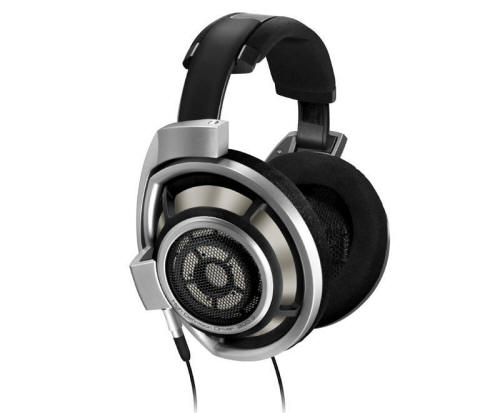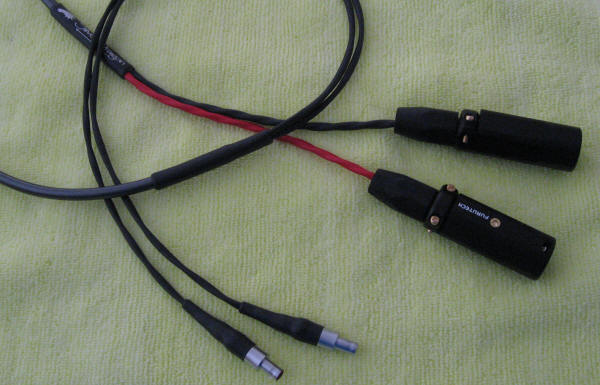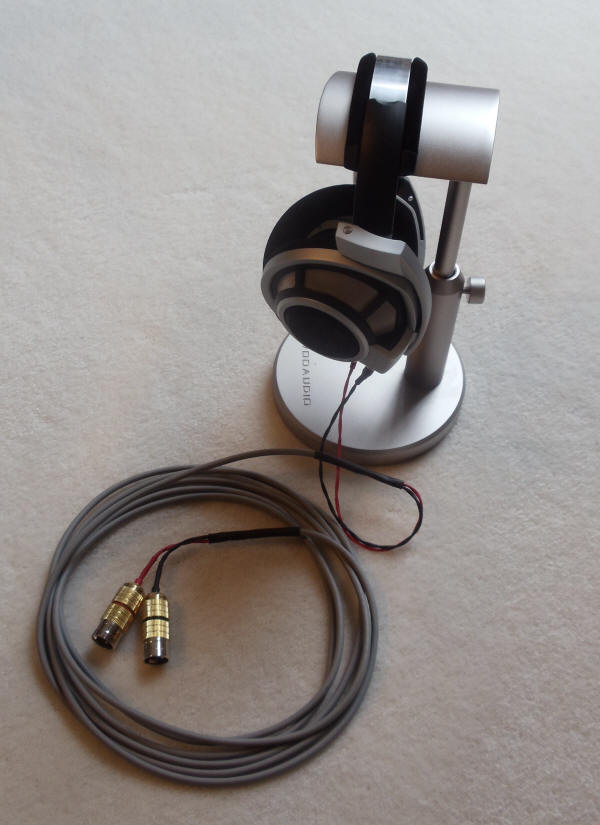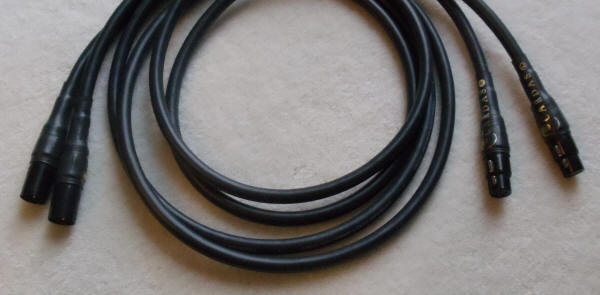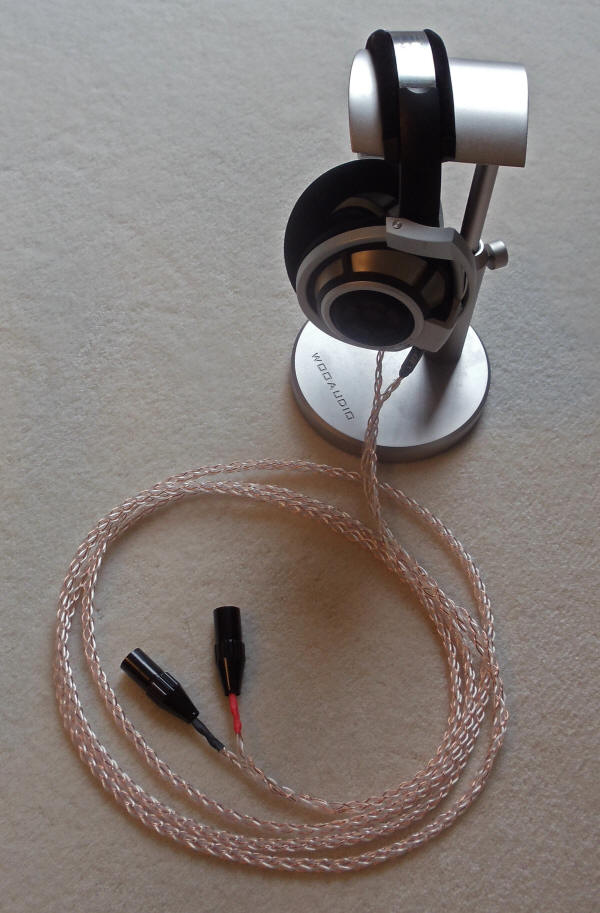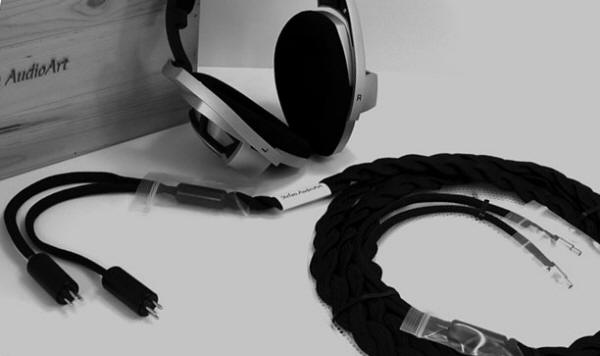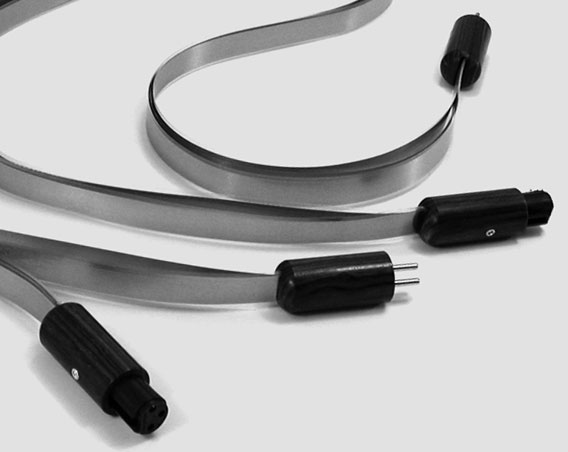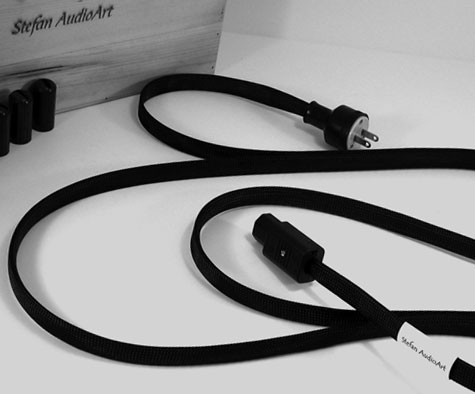|
You are reading the older HTML site
Positive Feedback ISSUE 54
A Tale of Four
Cities: After Market Cable Options for the Sennheiser HD800 Headphones
The ALO Audio HD800 RW8-SC Headphone Cables, the Cardas Audio HD800 Headphone Cables, the Moon Audio Silver Dragon V3 & Blue Dragon V3 HD800 Headphone Cables, and the Stefan AudioArt Endorphin WS HD800 Headphone Cables My children like to make fun of all my headphones lined up on a display rail. The cables look like a row of small tails from various marsupials waiting in the night for the music to begin. All of these tails began life in a different part of the good old USA, well before huddling cheek to cheek in my listening room. What do Portland (Oregon), Bandon (Oregon), Holly Springs (North Carolina), and West Hartford (Connecticut) all have in common? All of these locations have some very serious visionaries working on improving the sound quality of high-end cable and thus the enjoyment of recorded music. I can hear the sighs. The word "visionaries" to some might seem a little over dramatic and they are probably right. After all, in terms of today's world order, aren't we just talking about interconnects, speaker cable, power cords and headphone cable? Yes, we should keep this all in the proper perspective, but I am serious and so are these folks! Many argue about value and pricing, but few argue about the improving effects that cable can bring to the sound of your system. The design and execution of these products is an equal combination of science and art. Manufacturing processes, metallurgy, metal purity, alloy combinations, solder content, insulation options, connector options, physical design, and geometry—the list of variables are endless. Each decision can affect the quality of sound in several different dimensions. Each resulting design can have a wonderful synergy in some systems and can spell disaster in others. This review will examine four different aftermarket headphone cables for the Sennheiser HD800 headphones. At a list price of approximately $1,500, the HD800 has been proclaimed by many as the finest dynamic headphone available today. On the other hand, several very expensive models from Grado, Denon, Byerdynamic, Ultrasone, Shure and others have now entered the market in the last 12 months, so the race is on. Like all things audiophile, there is now a strong demand for tweaking the HD800 to improve the sound even further. Aftermarket cables are just one of many ways to do this. As a starting point, please see my review at 6moons.com on the HD800 and the Woo Audio WA22 headphone amp. This article will help provide a more in-depth examination of both products and give you a solid foundation for the analysis in this review. (Without letting too much of the cat out of the bag, I need to state up front that we have four big winners here. All have impressive strengths and value at their respective price points. Current and future HD800 owners should feel very fortunate to have these options.) Evolving Personal Criteria I am gonna ruffle a few feathers now. My personal priorities for evaluating sound performance have changed. After experiencing three incredible breakthrough products in the last six months, I feel like the grandfather in the movie Moonstruck: "I am so confused!" On the other hand, some might argue that I am now enlightened. The Magico Q5 Speakers, the Argento Flow Interconnects, and the Woo Audio WES Electrostatic Headphone System have me now standing on my head (in hockey parlance). For years, I straddled the fence like many on the "musical" vs. "analytical" argument. No longer. I know that it is sacrilegious, but I don't want to hear any more about sound that is "musical", or "analog" or "organic". I don't care anymore if we are talking about analog or digital sources. For me, all of these words are non-descriptive after listening to these three products. Like most of us, reality is the target. For me, this now means speed, detail, and slam. I want air and soundstage way, way, way beyond the speakers. I want to hear the air conditioning system in the recording studio. I want to be dramatically sucked into the sound and shoved back on occasion too. Yes, proper weight and timbre is critical, but I want goose bumps and I want the hair to stand up on my neck. I want to see the peach fuzz on the peach. I am a man of the new millennium. I want it all. If I want that so called "analog" sound and the ability to relax and ease into the music, then I will turn the sound down and have a glass of 30 year old Glenkinchie Scotch or 2003 Colgin Caried Red (depending on the day and mood of course). Again, my needs are evolving after listening to these three products. There. I said it. I feel better. Caveat Emptor Based on all of the above new priorities and personal biases, I probably need to provide the usual "buyer beware" statements. System synergies and personal taste is critical when considering these products. This review is based on my subjective tastes, my subjective ears, and my specific headphone system. These combinations of components are only a few data points of the many that exist out there. Please consider my comments and analysis appropriately. System Description For this review, I will be using my Sennheiser HD800 Headphones, Woo Audio WA22 Headphone Amp, and two SACD/CD player sources: the EMM Labs CDSA and the new Oppo BDP-95. This is a fully balanced end-to-end system. It is my opinion that a fully balanced headphone system is far superior to a single ended system. Again, please see my review referenced above at 6moons.com for more logic and insight. Current interconnects and power cables for my headphone system are all TG Audio Silver. It was suggested that for the best sound quality, I should consider using the same brand of cable throughout the system. All the contenders were offered this opportunity. Cardas and Stefan AudioArt followed through for both interconnects and power cables. Moon Audio sent an additional Silver Dragon interconnect. ALO was not able to send these components during the period that I needed them, but they may send power cables and interconnects later for some follow up comments. I am not going to get into the endless combinations of utilizing one brand or multiple brands, but let's just say that the results were a no-brainer. Everything seemed more in synch and correct when using one brand. I ended up using Cardas interconnects and power cables with the ALO headphone cables. For the ALO cable, this provided the most neutral combination and best performance – a nice compliment and tip of the cap to Cardas. I was also questioned by more than one of the venders about isolation and power. These were fair questions. It just verified the level of detail and commitment that these folks have to their products and their performance. Just for the record, I used a Rix Rax Hoodoo component rack with over one hundred pounds of sand within the steel tube structure. All shelves are solid maple. Please see the included picture. I also experimented with some home brew racquetball and PVC collar isolation. I do not use conditioned power. I do have several dedicated 20 amp circuits connected directly from my fuse box to my listening room. Virtually every component in my system has its own circuit. Burn In All new headphone cables, interconnects and power cables were burned in for ten days or longer. I changed CDs every couple of days to work in various types of music and sound levels. For two non-successive days within that period, I ran the IsoTek Full System Enhancer and Rejuvenation Disc. Needless to say, I hope to take a long deep breath before my next cable review. Of course, if the orders come down the line from our fearless leader Dr. David Robinson, I will find a way to salute! Stock Sennheiser HD800 Headphone Cable When working through my due diligence and before purchasing the Sennheiser HD800 last year, I read numerous comments on the Internet that the stock headphone cable was fairly good considering the performance of most stock cables. For me, even after 1000 hours of burn in time, I found the sound to be somewhat confused and phasey. There was a definite midrange suck-out on some recordings but not on others. This was very frustrating. There was always a very light metallic haze hovering over all frequencies despite trying several different sources, amplifiers, interconnects and power cords. Both ends of the frequency spectrum were adequate but not overly impressive. I was beginning to wonder if the HD800 was really worth the $1500 and justified all the hype. I did experiment with a few aftermarket cables with some success, but I always had this funny feeling that there was plenty of untapped potential. Enter these four excellent headphone cable options. Moon Audio (Holly Springs, North Carolina)
Moon Audio Balanced Silver Dragon V3 HD800 Headphone Cable (10 feet) - $425 Moon Audio Balanced Blue Dragon V3 HD800 Headphone Cable (10 feet) - $300
Moon Audio Balanced Silver Dragon V2 Interconnects (1 meter) - $450 Drew Baird and Moon Audio are well-known fixtures in the headphone community. Google any of the Internet audiophile review sites or go to http://www.head-fi.org and you will see plenty of positive comments and feedback. Drew has two more success stories in his Blue Dragon V3 and Silver Dragon V3 cables. Remember that the price of silver these days has gone through the roof. As with all the venders, please check the Moon Audio web site to verify current pricing. The Silver Dragon V3 headphone cable utilizes high purity 24 AWG stranded silver conductors. The Blue Dragon V3 utilizes high purity 24 AWG stranded copper conductors. For both silver and copper, the current level of purity is a step up from prior Moon Audio designs. Both models surround all conductors with cotton insulation and a layer of Teflon tape. Both are then shielded and placed in a polyethylene jacket. Cardas solder is used throughout. Furutech XLR connectors are used for both. The Silver Dragon V2 interconnects utilize high purity 26 AWG shielded silver conductors. Teflon insulation is used from end to end. Like the headphone cables, high quality Furutech XLR connectors are included in the base configuration. (Check the website for Furutech options and prices.) This newest Silver Dragon V2 also includes a new braided geometry that is said to improve noise rejection. At these prices, both the Silver Dragon V3 and Blue Dragon V3 are clearly contenders for the "most bang-for-the-buck" award. They can compete with the more expensive brands on virtually every level. One word that keeps coming up in my notes is "smooth". Don't let this mislead you on sound. Both cables have plenty of speed and detail. The copper Blue Dragon has slightly more weight, texture, and roundness. Female vocals take on a wonderful creamy perspective, but not that much richer than the Silver Dragon. In my tube-based system, I prefer the Silver Dragon. More information is communicated. Speed and detail is even more impressive. I can hear into the corners of the recording venue and there seems to be a bigger more airy sound stage. There is absolutely no digital edge with either cable. My father-in-law made his living as a doctor in internal medicine. Pulmonary disease was his specialty. As a young man, he also sang opera. Look out after a few glasses of wine and a good Italian dinner! He was, and still is, a huge fan of all forms of classical music. When he retired and moved from his home to a smaller condominium a few years back, he sold off his stereo system and gave me his total collection of pristine RCA Living Stereo LPs. In this case only, thank gosh for iPod based listening platforms and for going small when retiring. It seems like a smile has never left my face since that day. I have always found these LPs an absolute delight to listen to. Not so much on the RCA SACDs of these same titles. Until now. For example, the RCA Living Stereo Offenbach Gaite Parisienne with Arthur Fiedler and the Boston Pops is considered a classic and one of the best recordings of all time. Until now, the SACD sounded slightly tame to my ears when compared with the LP. With the HD800/WA22/MA Silver Dragon combination, though, the SACD was goose bump city all over again. The layers and layers of strings, woodwinds, and brass were now clearly delineated, with proper timbre and air. The clattering of percussion and the bubbly pace of the conductor come through loud and clear. You can almost see the dancers enter the stage with legs kicking high and skirts flowing left and right (sorry for the drama—buts it's all good). Cardas Audio (Bandon, Oregon)
Cardas Balanced HD800 Headphone Cable (10 feet) - $438
Cardas Balanced Golden Reference Interconnects (1 meter) - $1138 Cardas Golden Reference Power Cord (2 meters) - $722 Few would argue that George Cardas is one of our most important industry leaders. As one of the pioneers in the development of audiophile cable, Cardas Audio continues down the path of providing cutting-edge design and execution. George probably does not remember, but I met him a couple of times back in the day when the Consumer Electronics Show (CES) was held annually in Chicago. This was in the early '90s, before CES moved to Las Vegas. He struck me as quite the gentleman back then, with plenty of innovative thinking and vision for the future. I had a gut feeling that Cardas Audio was going places, and both time and success has supported that prediction. A golden legacy of superb products and an excellent reputation for customer support and satisfaction should have high value to the consumer - at least in my book. His products are still some of the best by any criteria. Fit and finish for all the Cardas cable products was excellent—probably the best of the bunch. Cardas follows their Golden Ratio geometry for all models. Please see the Cardas website (http://www.cardas.com) for a more in-depth explanation of this geometry and philosophy. Thicker and heavier does not necessarily mean better sound, but for this price, it is nice to feel like you are getting something of substance. The Cardas HD800 headphone cable utilizes four 23.5 AWG pure copper Litz conductors. The overall design is fully-shielded with a semi-conductive Teflon insulation. Custom Cardas XLR connectors are used with a silver plating and rhodium flashing. The Golden Reference power cords and Golden Reference interconnects look and feel like thick and elegantly finished transmission cable—the type we liked to use at Bell Laboratories for bundles of T1 lines. Well, this might be a bit of an exaggeration, but they are massive. All male and female connectors are from Furutech. Industrial grade insulation and heat shrink are used throughout. This is one very handsome product line. As I said earlier, ALO Audio was not able to send me interconnects and power cords during the review period. Cardas interconnects and power cords were the most synergistic with ALO, as they were with all four product lines when mixing and matching (this included comparisons with my TG Audio cables). This may have important implications if you don't plan on or cannot afford to replace all the wire in your system with one brand. I found all the Cardas products to be very neutral with just a touch of midrange warmth and additional low-end weight. Depending on the system, this can be very appealing. Speed and detail were excellent, though for example, I heard more of the wood body of a violin than the shimmer of the strings. Mids were addictive with a rich and seductive flavor. Female vocalists were warm and clear without any chestiness and with plenty of air and detail. Cardas delivered some of the best bass performance of all four product lines. When listening to the Mort The Cat CD by Donald Fagen, check out the title track for a good test of bass. Admittedly, some of the low end is goosed up a bit on this recording, but even with a tube-based amp, Cardas delivered the goods without boom or overhang. Weight, texture, and slam were outstanding. ALO Audio (Portland, Oregon)
ALO Audio Balanced RW8-SC HD800 Headphone Cable - $725 Ken Ball has a long-term history and commitment to high-end headphones and related electronics, cable and accessories. Even beyond ALO Audio, Ken has now established a storefront in Portland Oregon called "32 Ohm Audio" that supports some of the latest and greatest headphone products and top brands. One key objective for the store is to help customers maximize the audio performance of their iPods, iPhones, iPads, and computers. 32 Ohm Audio also carries various smaller scale products for the home including speakers, DACs, and amplifiers. Always a highlight at the Head-Fi and Can Jam conferences, Ken and ALO continue to evolve their product lines and specifically their headphone cables. For this review, Ken sent me a new product that was designed specifically for the Sennheiser HD800. The ALO Audio RW-SC Headphone Cable has a unique geometry that utilizes a stranded high purity copper. Braided 22 AWG conductors are silver plated and insulated with Teflon and a clear polyethylene jacket. Cryogenic processes are used to further improve performance. I had similar initial reactions to both the ALO and Stefan ArtAudio (SA) headphone cables. (See my specific comments on SA below.) My notes for both consistently referenced impressive new levels of "transparency" and "PRAT" (pace, rhythm, attack, and timing). The proverbial audiophile metaphors are still the best way to describe what I was hearing. It sounded like the glass was finally wiped clean and the sunshine was pouring through. The ALO cable provided an expansive soundstage with a prodigious amount of reach and information. Imaging was tight and airy. Bass had good slam with benchmark levels of detail and texture. Highs were exhilarating. In contrast to Cardas, when listening to violins I heard more of the shimmer of strings than the wood tone of the violin body. Neither is absolutely correct. Personal biases will dictate your preference. The ALO cable had me consistently sitting on the edge of my seat yet without any digital edge or listening fatigue. One of my favorite SACDs is Blue Country Heart by Jorma Kaukonen. As you may know, Jorma Kaukonen is an original member of Jefferson Airplane and Hot Tuna. I love some of the classic Jefferson Airplane albums (not so much Jefferson Starship), but IMHO JK's guitar clearly shines brighter when performing with Hot Tuna or with a focus on acoustic blues and bluegrass music. Blue Country Heart feels like a bunch of good ole boys that just got together on the porch one day for a little friendly jamming, moonshine and a few laughs. Mandolins, fiddles, banjos, dobros, acoustic guitars and stand-up bass never sounded better. The soundstage is huge. Images are dialed in. Inner detail, timbre, and weight are balanced in a way that I have never experienced before on this recording. All I can say is, pass the jug please!! Stefan AudioArt (West Hartford, Connecticut)
Stefan AudioArt Balanced Endorphin WS HD800 Headphone Cable (10 feet) - $1249
Stefan AudioArt Balanced Endorphin Ribbon Interconnects (1 meter) - $449
Stefan AudioArt Endorphin Ribbon Power Cable (6 feet) - $379 James Serdechny is a former Sennheiser Applications Engineer with extensive experience with many of the major high-end headphone brands. His résumé also includes the design and installation of cables for various audiophile recording studios. James has some unique and very creative ideas about cable design and execution. More impressively, he has moved forward with these ideas while bucking the latest trends and traditional thinking. Out-of-the-box creative design is one thing. Bringing them to market is still another. James has managed to do this and more. One thing was clear from my first communications with James. He is a man who is defined by the details. Everything from the way his cable is packaged and shipped to basic requirements for isolation and power had additional levels of logic and engineering. The physical design and geometry of both the Stefan AudioArt (SA) Endorphin interconnects and power cords were significantly different from the other contenders. This includes the use of high purity copper ribbon conductors, the application of multiple hybrid conductive materials, proprietary electro/chemical treatments and the elimination of hard wall shells on XLR connectors (see the included pictures to better understand this last feature). The power cords were also designed to eliminate ground for better polarity matching. See the SA web site for a more technical description and explanation behind these design choices. The balanced Endorphin WS HD800 headphone cable utilizes ebony wood splitters and ebony wood XLR connectors. Similar to the interconnects and power cords, the Endorphin headphone cable incorporates a combination of high purity copper conductors, the application of layers of multiple hybrid conductive materials, and a proprietary conductive surface treatment. The hard wall shells on the XLR connectors have been eliminated. An elegant black cotton-like material is used as a protective jacket over the entire cable. Check out all the pictures. Sexy stuff. Does all this innovation translate to superior sound? We shall see. As I stated in my earlier comments, the ALO RW8-SC and SA Endorphin headphone cables were clear winners when it comes to transparency and PRAT. At first, I could only detect subtle differences between the two when compared head to head and using the exact same interconnects and power cables. All other variables were also held constant. A few weeks later, the SA Endorphin interconnects and power cords arrived. After ten days of burn in, I installed the Endorphin interconnects and power cords into the system. After determining the proper polarity on the power cords through a few hours of listening (a frustrating but rewarding exercise), I settled in for some serious listening. It was clear from the first few notes that another veil had been lifted. Additional transparency and PRAT improvements were undeniable. Speed, detail, and slam were now the best I have heard in this system. That statement is saying a bunch considering the excellent performance of the ALO headphone cable. Throughout this process, my wife listened to all four contenders and her comments were always fairly close to what I was experiencing. Her translation of what she was now hearing with the system fully wired with Endorphin added additional insight. From her perspective, both ALO and SA cables had superior levels of transparency and PRAT, but the SA Endorphin had taken on an additional if not a more correct sense of timbre and weight (without losing any of the former). The sound was very pure and rich. Some of the toughest tests for sound quality like piano and female vocals were now sounding frightfully close to the real thing. Inner detail on acoustic and electric bass was just breath taking. OMG's were flying as I watched her body language and facial expressions. It was difficult to focus on my Sunday morning newspaper with all the giggling going on. Yes, this marriage is all about harmony (well, most of time). Though we both agreed on what we were now hearing, I could only wonder what the system might sound like fully wired with ALO cable. Hopefully I can provide some additional comments down the road if and when I hear this combination. Red Rose Music is an SACD produced and recorded by Mark Levinson (yes, that Mark Levinson). I rarely use this SACD for evaluating equipment because it always sounds fantastic in any system regardless of configuration and price. This pure DSD recording was made with a simple recording chain: two microphones, one power supply, and a preamplifier feeding a Sony DSD recorder. This time around, I was hearing something very different. New benchmarks were being established. Yes, the illusion of reality was closer than ever. Track 8, "Going Back To Louisiana" is a wonderful blues piece performed by Bill Sims on guitar and Chico Freeman on tenor sax. Talk about being drawn into the subtle vibrations of both the body and reed of a saxophone—this was the real deal. There was no confusion that we were listening to a real "ole timey" steel string guitar—not nylon or any other variation. Bill Sims gravelly voice showed its wear and tear like never before. Images were locked in as you could hear and visualize them both swaying and turning during the session. Track 4, "Recitation in Scherzo for Solo Violin" by Fritz Kreisler is another closely microphoned solo piece performed by Adele V. Anthony using a Guarnari del Jesu violint. I am no violin expert, but the tone and pitch of this instrument sounded shockingly real to me. In this case, there was a perfect balance between the shimmer of the strings and the natural tone of the wood body. The dynamic range of this recording is always impressive, but now it was almost startling. Even though I was listening to headphones and not standalone speakers, you could easily sense the outline of Ms. Anthony and the violin positioned in space. Final Thoughts These last few months have been a real learning experience. My respect for the potential of headphone systems is now clear and without compromise. If listening space were an issue, I could easily live without my standalone system. Cable can make a significant difference, but it is still all about personal preferences and system synergies. Again, current and future owners of the Sennheiser HD800 headphones should feel fortunate to have these four outstanding cable options. And finally, the Sennheiser HD800 headphones are truly a state-of-the-art accomplishment. Manufacturers ALO Audio www.aloaudio.com Cardas Audio www.cardas.com Moon Audio www.moon-audio.com Stefan AudioArt www.stefanaudioart.com
|

